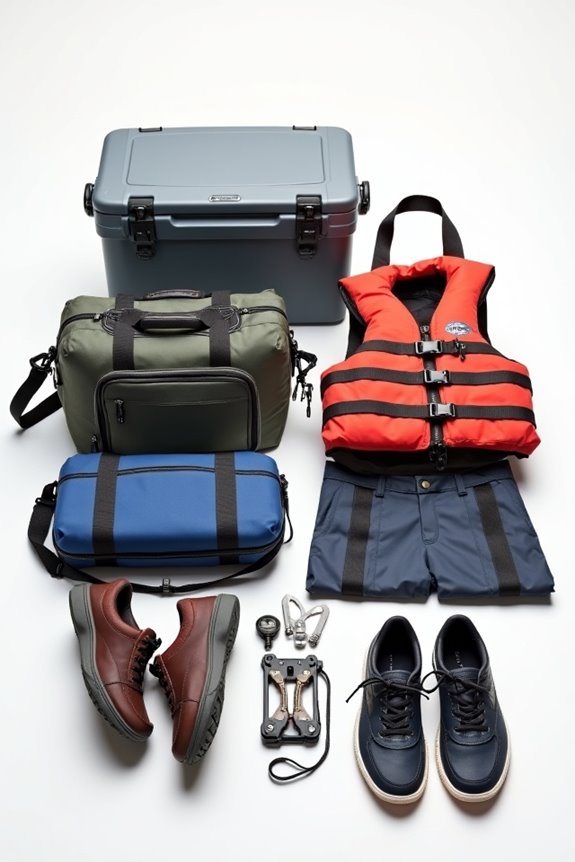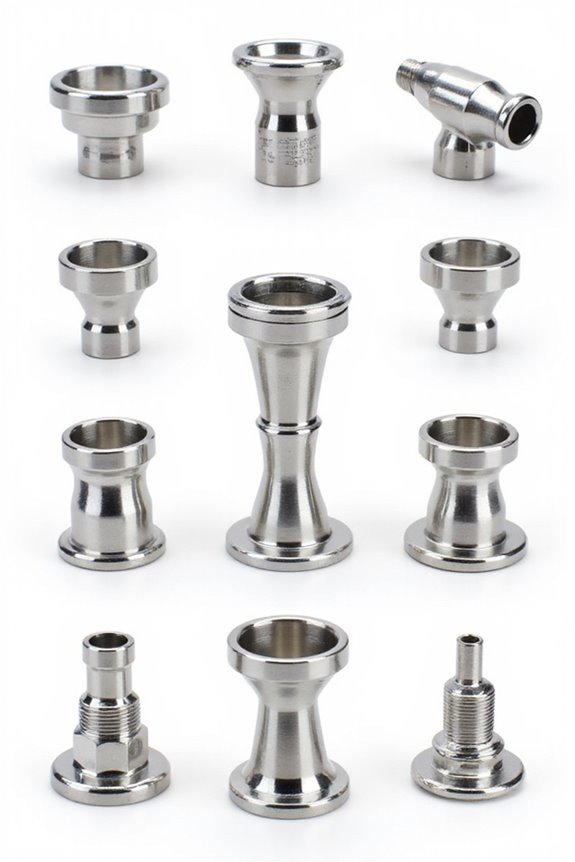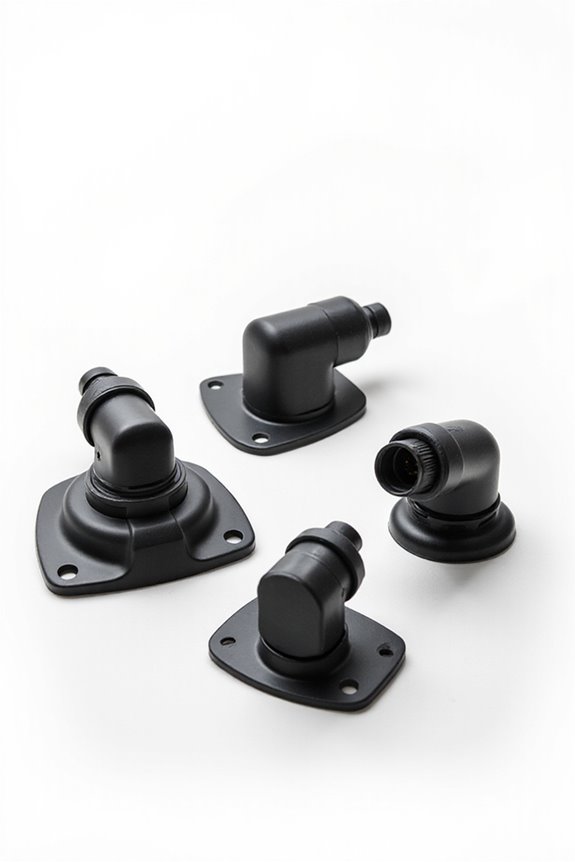As an Amazon Associate, we earn from qualifying purchases. Some links may be affiliate links at no extra cost to you. Although our opinions are based on curated research, we haven't used these products. Articles generated with AI.
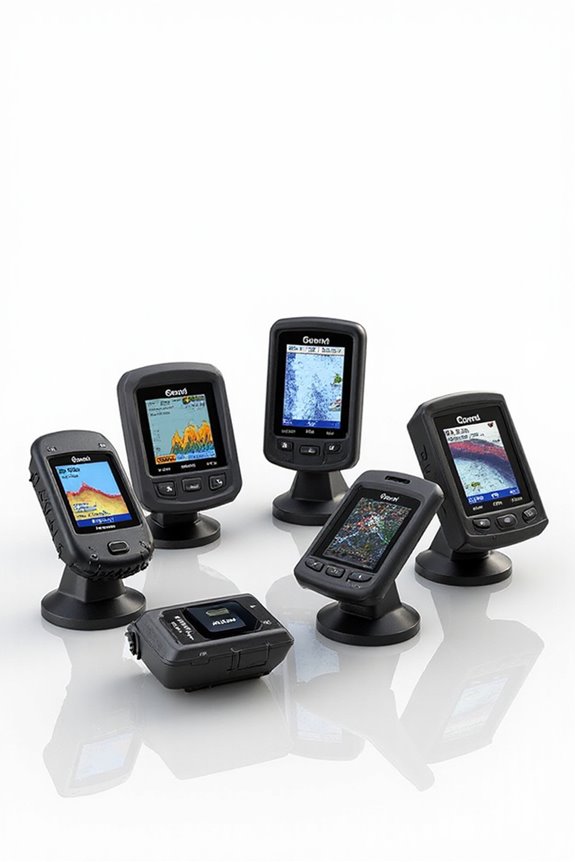
5 Best Ice Fishing Flasher Sonars of 2025 – Your Ultimate Guide to Finding Fish Under the Ice
If you’re gearing up for ice fishing in 2025, you’ll want the right flasher sonar to guarantee a successful trip. Consider the LUCKYLAKER Portable Sonar for its lightweight design and easy-to-read display. The Garmin Striker 4 offers advanced sonar tech, while the LUCKY Portable Sonar is budget-friendly and effective. If you’re serious, check out the Humminbird 411750-1 for its GPS features. Want to know what else to keep in mind? Let’s explore more!
Key Takeaways
- Look for models with high-resolution, full-color displays for clear visibility of fish arches and depth readings under the ice.
- Prioritize sonar technology like CHIRP for enhanced clarity and accuracy in tracking fish movements and bottom contours.
- Choose ice fishing flashers with at least 5 to 10 hours of battery life to ensure extended fishing trips without interruptions.
- Consider user-friendly interfaces with dedicated buttons for ease of use while wearing gloves in cold conditions.
- Evaluate the portability and weight of the unit, ensuring it is easy to transport for various fishing locations.
LUCKYLAKER Portable Sonar Kayak Fish Finder
LUCKYLAKER Sonar Kayak Fish Finder Portable Water Handheld Depth Finder Boat Transducer Wireless...
- Wireless Sonar Transducer: The wireless fish finder can support 196FT(60m) wireless operating range and can be immersed in the water directly. There is no technical...
- Fish Size Display: The portable fish finder divide the size of fishes into large, medium and small as icons displayed on the screen. In some extent, the size of the...
- High Quality of Screen Display: The 2.4-inch TFT color LCD screen transducer fish finder has three colors to display the bottom contour information, which is clear and...
If you’re looking to enhance your ice fishing experience, the LUCKYLAKER Portable Sonar Kayak Fish Finder is a stellar choice for both beginners and seasoned anglers. Weighing in at just 1.19 lbs, it’s super easy to carry around. With its 2.4-inch TFT color LCD, you’ll love how clear the display is, showing real-time information on fish size and depth. You can even set it to alert you when fish are nearby—pretty nifty, right? Plus, the rechargeable battery lasts 4-5 hours, meaning you can fish all day. Just remember, while some reviews are glowing, others hint at accuracy issues, so keep that in mind.
Best For: The LUCKYLAKER Portable Sonar Kayak Fish Finder is best for both beginners and experienced anglers looking for a lightweight, portable solution for real-time fishing insights.
Pros:
- Lightweight and portable (1.19 lbs) for easy transport while fishing.
- Clear display with real-time fish size and depth information on a 2.4-inch TFT color LCD.
- Rechargeable battery lasts 4-5 hours, allowing for extended fishing sessions.
Cons:
- Some users report accuracy issues with depth measurements and display consistency.
- Mixed customer feedback indicates potential reliability concerns.
- Best Sellers Rank suggests it may face competition from other fish finders in the market.
Garmin Striker 4 with Portable Kit
Sale
Garmin 010-01550-10 Striker 4 Fish-Finder with Portable kit, 3.5"
- The power of simple - offers a keyed interface with dedicated buttons. The Device is easy to use and easy to install. Available in 3.5-, 5- and 7-inch display sizes
- Waypoint map - use the waypoint map to easily view, Mark and navigate to locations such as brush piles, stumps and docks
- Chirp sonar - Chirp sends a continuous sweep of frequencies which provides a wider range of information. Chirp sonar is able to create crisper fish arches with better...
The Garmin Striker 4 with Portable Kit is an ice fishing enthusiast’s best friend, especially if you’re seeking versatility in one compact package. With display sizes from 3.5 to 7 inches, you can easily read your sonar data, whether you’re on a small boat or sitting on the ice. Plus, it packs a powerful CHIRP sonar for crisp fish arches, making it easier to find that elusive catch. Battery life is impressive, lasting up to 10 hours, so you won’t miss out on prime fishing time. Just remember, a little YouTube help might come in handy for setup! Happy fishing!
Best For: Ice fishing enthusiasts and anglers looking for a versatile and compact fish finder that can be used on small boats and kayaks.
Pros:
- Long-lasting battery life of up to 10 hours, allowing for extended fishing trips without interruptions.
- Clear and detailed sonar data thanks to the advanced CHIRP sonar technology.
- Compact and portable design, making it easy to transport and set up for both summer and winter fishing.
Cons:
- Setup instructions may be unclear, leading some users to rely on external resources like YouTube tutorials.
- Lacks detailed maps, limiting navigation capabilities compared to higher-end models.
- Some users may find the smaller display size less optimal for viewing in bright conditions.
LUCKY Portable Sonar Fish Finder for Fishing
LUCKY Portable Sonar Fish Finder Boat Depth Fishing Fish Finders Waterproof Handheld Wireless...
- Waterproof : The sonar fish finder is waterproof in rains. No need to worry the splashes makes the display damaged any more. Even though the sonar fish finder dropped...
- Wireless & Castable : The sonar transducer supports max 656ft wireless operation and max 147ft water depth detection. The sonar ball is lightweight and compact and you...
- Water Depth & Data Display : The sonar fish finder displays water depth, fish approximate location, fish size (small,middle,big), water temperature, bottom contour and so...
For anglers who love flexibility, the LUCKY Portable Sonar Fish Finder is a game changer. This handheld, waterproof device works wonders whether you’re ice fishing, kayaking, or bank fishing. With a wireless range of 328 feet and a depth detection up to 147 feet, it gives you valuable info right at your fingertips. Catch accurate readings on fish size, water temperature, and bottom contour. Plus, its glowing cap makes nighttime fishing a breeze! While some users mention minor waterproofing concerns, it’s still a solid, budget-friendly option. So, why not reel in your next catch with this nifty gadget? You won’t regret it!
Best For: Casual anglers seeking a portable and budget-friendly fish finder for various fishing environments.
Pros:
- Compact and lightweight design, making it easy to carry and use without cumbersome cables.
- Wireless operation up to 328 feet, providing flexibility in fishing locations.
- Multi-functional display shows critical information including fish size, water depth, and temperature.
Cons:
- Some users reported issues with waterproofing and potential inaccuracies in readings.
- Lacks advanced features found in higher-end fish finder models.
- Battery life may vary depending on usage, with some noting the need for careful handling.
LUCKYLAKER Portable Display Fish Finder
LUCKYLAKER Portable Display Fish Finder Boat Handheld Transducer Fish Finders Kayak Water Sensor...
- High Quality of Screen Display: The 2.4inch TFT LCD screen portable fish finder uses three colors to provides bottom contour data which has high contrast for seeing...
- Fishes Size Display: The portable fish finder uses three different size icons to show how large of the fishes. Knowing the size of fishes could increase the possibility...
- Updated Various Function: The transducer fish finder provides accurate real time data, including fish position, depth of water. In addition, the fish depth finder...
Imagine sitting on a frozen lake, waiting for that telltale tug on your line. The LUCKYLAKER Portable Display Fish Finder might just become your new best fishing buddy! With a vibrant 2.4-inch TFT LCD, it clearly shows fish size and depth, plus water temperature. Whether you’re a novice or a pro, its simplicity is a game-changer. You can even attach it to your kayak or Jon boat, making it super versatile. Customers love its performance, rating it 4.0 stars, but remember—keep it out of direct sunlight! At under $100, it’s an awesome tool for ice fishing adventures.
Best For: The LUCKYLAKER Portable Display Fish Finder is best for both novice and experienced anglers looking for an affordable and versatile tool to enhance their fishing experience.
Pros:
- Clear Display: The 2.4-inch TFT LCD screen provides high contrast for easy reading of fish size and water depth.
- Versatile Use: It can be used for various fishing scenarios, including kayak fishing, Jon boat fishing, and ice fishing.
- Lightweight and Portable: Weighing only 0.72 kg, it is easy to transport for fishing trips.
Cons:
- Sunlight Visibility: The display can be difficult to see in direct sunlight.
- Non-Waterproof: Care must be taken to keep the device away from water exposure.
- Limited Depth Measurement: The maximum measuring depth of 328 feet may not be sufficient for deep water fishing.
Humminbird 411750-1 ICE Helix 7 Chirp GPS G4
Humminbird ICE Helix 7 G4 GPS Fish Finder with Dual Spectrum Chirp Sonar
- Dual Spectrum CHIRP: Crisp fish arches and bottom detail in ICE mode
- All‑Season Ready: Bundle options include open‑water transducer and mounts
- Custom ICE Views: Flasher, A‑Scope, zoom and interference rejection modes
Looking for the perfect companion for your ice fishing adventures? The Humminbird 411750-1 ICE Helix 7 Chirp GPS G4 has you covered! With a dazzling 7-inch ultra-bright display, you’ll easily spot fish, bait, and structures under ice. Its dual-spectrum CHIRP sonar even gives you high-resolution returns and a fantastic target separation down to 3/4. Need precision? The built-in GPS lets you mark waypoints and navigate effortlessly. Plus, the Jig Charge Mode is a game-changer for ice anglers. At only 6.78 kilograms, it’s lightweight yet packed with features. Let’s catch some fish without getting lost, shall we?
Best For: Ice fishing enthusiasts looking for an advanced fish finder with GPS capabilities.
Pros:
- High-resolution dual-spectrum CHIRP sonar allows for detailed visibility of fish and underwater structures.
- Integrated GPS enables easy waypoint marking and navigation across over 10,000 lakes.
- Lightweight at 6.78 kg and includes a convenient lithium battery for portability and extended fishing trips.
Cons:
- Price point may be higher compared to basic fish finders, making it a larger investment for casual anglers.
- Learning curve for new users who may not be familiar with advanced sonar and GPS functionalities.
- Dependence on battery life; extended usage may require additional battery management or charging.
Factors to Consider When Choosing an Ice Fishing Flasher Sonar
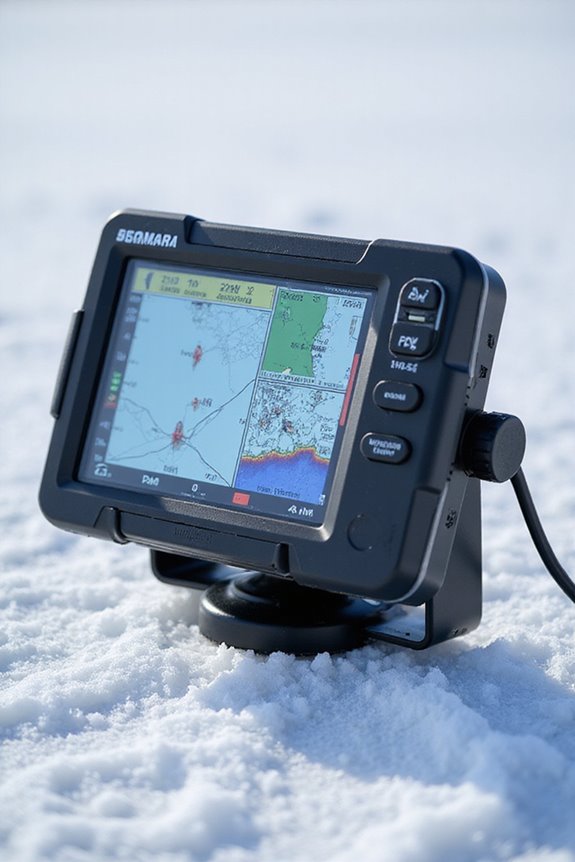
When you’re choosing an ice fishing flasher sonar, you’ve got a few key factors to take into account. Display size, battery life, and the type of sonar technology can make all the difference in your fishing experience. Plus, think about how portable it is and whether the user interface is friendly enough so you won’t need a degree in engineering to understand it!
Display Size Options
Choosing the right display size for your ice fishing flasher sonar can feel a bit like picking the perfect ice hole—there’s more to it than you might think! Most flashers have displays ranging from 3.5 to 7 inches. A larger 7-inch screen is fantastic for spotting fish and underwater structures, especially in bright or low-light conditions. But if you’re all about mobility, a compact 3.5-inch model might be your cup of tea. Just remember, clarity is key! High-resolution screens make all the difference, allowing you to see fish arches and depth readings clearly. Plus, full-color displays boost your ability to differentiate fish and bottom contours—it’s like having a cheat sheet under the ice!
Battery Life Duration
Battery life duration is one of the key factors you need to weigh when selecting an ice fishing flasher sonar. Imagine sitting there for hours, hoping for a fish to bite, only to have your flasher die on you—talk about frustrating! Look for models offering 5 to 10 hours of battery life, or even longer with those fancy power-saving modes. Lithium-ion batteries are your best bet; they’re lightweight and last longer than the old lead-acid kinds. Don’t forget to check your battery status regularly and keep a backup handy. Cold temps can sap battery life, so consider using insulated cases to keep your power sources cozy. Keeping your battery warm is key—after all, we want to catch fish, not a cold!
Sonar Technology Types
Selecting the right sonar technology can make or break your ice fishing experience, so it’s worth diving into the options available. CHIRP sonar technology really stands out, offering improved clarity by sweeping frequencies. This means you’ll see more about fish and underwater structures. Then there’s traditional sonar, which operates on a single frequency—less reliable for accurate readings and target identification. If you want flexibility, dual-frequency sonar lets you switch between lower and higher frequencies, adapting to various water conditions. And don’t forget about flasher displays; they offer real-time, circular information about fish movement and your jigging action, keeping everything visible. With advanced features like interference rejection and adjustable zoom, you’ll learn to fish like a pro in no time!
Portable Design Features
When you’re out on the ice, the last thing you want is a bulky piece of equipment slowing you down. Look for a lightweight and compact ice fishing flasher sonar, ideally weighing around 1 to 2 pounds. You’ll also want a model with a long-lasting battery that can handle at least 10 hours of fishing. Having dedicated buttons instead of a touchscreen is a plus, especially when your fingers are too cold to function! A display of at least 5 inches guarantees you can read sonar readings, even in bright sunlight. Don’t forget about portability features like a built-in carrying case; they make transporting your gear a breeze! Remember, a happy angler catches more fish!
User Interface Usability
After you’ve found the perfect portable ice fishing flasher sonar, the next step is making sure the user interface works for you. You’ll want a user-friendly interface that allows for quick navigation, especially with those pesky gloves on. Look for keyed interfaces—dedicated buttons make life simpler, right? Also, check out the display clarity; high-resolution screens with adjustable brightness help you see in any lighting, whether it’s bright sunshine or twilight. Features like customizable layouts and split-screen views let you analyze multiple data streams at once. And don’t ignore the importance of clear instructional materials! A few helpful tutorials can turn you from a rookie to a pro in no time. Happy fishing!
Ice Fishing Specifics
One of the key factors to keep in mind when choosing an ice fishing flasher sonar is its sonar capability, often influenced by the frequency it operates at. Most flashers run at 200 kHz or more, which delivers high-resolution returns and enables better target separation. This is crucial when you’re peering through solid ice and looking for fish. You’ll also want a flasher with adjustable sonar zoom, helping you scrutinize specific depths like a detective on the case. Don’t forget the jig charge mode; it brightens your jig, making it irresistible to fish in dark waters. After all, who wouldn’t want their bait to stand out in the frozen abyss? Happy fishing!
Marking Waypoints
Marking waypoints is a game-changer for ice fishing enthusiasts, and here’s why: it lets you return to those hot spots without losing your mind or wandering aimlessly on the frozen tundra. Think about it—modern flashers and sonars often come with GPS that saves your favorite spots. You can easily navigate back, maximizing your fishing efficiency. Plus, as you track fish behavior and underwater structures, you’ll develop better strategies over time. Not to mention, accurate waypoints can help you dodge hidden hazards on the ice, keeping you safe while you’re on the hunt for that trophy catch. Some devices even let you create real-time contour maps to visualize key features, helping you refine your waypoint selection. Pretty neat, right?
Construction Durability Options
When you’re out on the ice, having a flasher that can take a beating is essential. You don’t want a flimsy device that’ll crack when you drop it, right? Look for rugged, waterproof materials that can handle ice and moisture without a hitch. Durable housing is a must; after all, your flasher should survive the bumps and tumbles of ice fishing adventures.
High-contrast, ultra-bright LCD screens are key—visibility matters in both bright sunlight and gloomy conditions. Plus, reinforced components, like sturdy transducer mounts, can weather freezing temperatures and heavy use. And let’s not forget battery life! Opt for high-capacity lithium batteries to keep your flasher running through long, productive fishing days. You’ll thank yourself later!
Frequently Asked Questions
How Do You Maintain an Ice Fishing Flasher Sonar?
Maintaining your ice fishing flasher sonar is as essential as keeping your favorite fishing lure sharp. First, always clean the transducer after each outing to prevent ice build-up. Keep the battery charged; a dead battery’s about as useful as a screen door on a submarine! Regularly check for software updates and inspect the connections. A little TLC goes a long way, ensuring your sonar’s ready to reveal the hidden treasure beneath the ice.
Are Flasher Sonars Waterproof for Ice Fishing?
You might be wondering if flasher sonars are waterproof for ice fishing. While many models are designed to withstand splashes and snow, they’re not completely submersible. So, if you drop one in the drink, it’s game over! To keep your sonar in tip-top shape, always handle it carefully, and avoid exposing it to excessive moisture. A little common sense goes a long way—after all, you want it to last through many ice-fishing adventures!
Can I Use a Flasher Sonar for Open Water Fishing?
Absolutely, you can use a flasher sonar for open water fishing! Just picture yourself on a calm lake, vibrant sun glittering on the surface, with that flasher lighting up the underwater world. It’ll help you locate fish and see how they’re reacting to your bait. Some adjustments may be needed since the sonar settings might differ in open water. But hey, who doesn’t love a little challenge, right? Give it a shot!
What Is the Average Battery Life of Ice Fishing Flashers?
The average battery life of ice fishing flashers typically ranges from 8 to 20 hours, depending on the model and settings you use. You wouldn’t want your flasher dying when the fish start biting, right? Keep in mind that higher brightness settings and extended use can drain the battery faster. So, it’s wise to carry a backup power source, just in case – because nobody wants a flasher that’s out of juice when the big catch arrives!
Do Flasher Sonars Come With a Warranty?
You might be wondering if your shiny new flasher sonar has any sort of safety net, right? Most reputable brands do offer warranties, typically ranging from one to three years. This covers defects in materials or workmanship—so you won’t be left high and dry if something goes wrong. Just make sure you read the fine print, since some warranties have specific conditions. Who knew fishing could come with a side of peace of mind?






